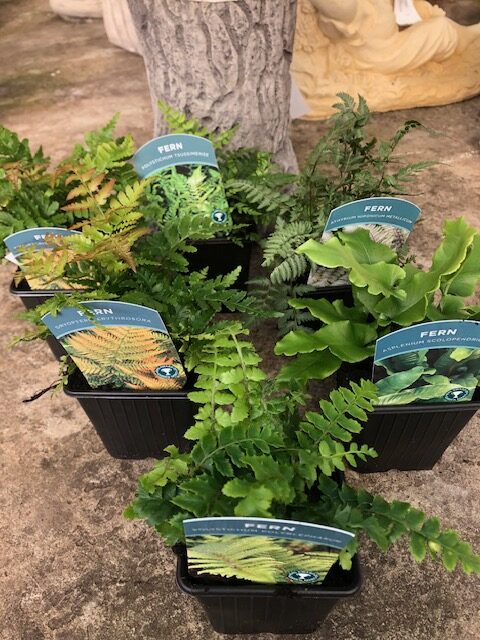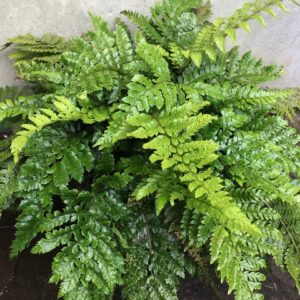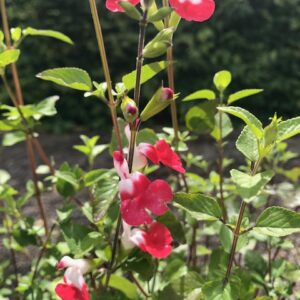Fern bundle
Growing Ferns in Your Garden.
Creating a Green Oasis of Natural Beauty.
Ferns have an enduring charm that can change the mood of a garden dramatically. With their delicate fronds and lush, vibrant greenery, they add a touch of elegance and mystery to any garden. Whether you have a small urban oasis or a sprawling countryside haven, ferns can thrive in a wide range of conditions. We will take a look at this fascinating world of growing ferns in your garden, sharing essential tips and insights to help you create a verdant, tranquil haven.
Choosing the Right Ferns
The first step in cultivating a thriving fern garden is selecting the right fern species for your location. Ferns are incredibly diverse, with thousands of species to choose from. Some ferns prefer deep shade, while others can tolerate dappled sunlight. Our bundle will include easy to grow varieties both evergreen and non evergreen to start you off or include in your own garden. Each type has its own unique appearance, growth habits, and habitat preferences, but generally require little attention once established.
The Perfect Location
Ferns, with their origins dating back millions of years, are typically forest understory plants. They thrive in partial to full shade, making them an excellent choice for gardens with limited direct sunlight. When planning your fern garden, look for areas with dappled sunlight or filtered light, such as under tall trees or on the north side of a building. This will mimic their natural habitat and provide the ideal environment for your ferns to flourish.
Soil Preparation
Ferns are relatively low-maintenance, but they do have specific soil requirements. They prefer moist, well-draining soil rich in organic matter. Amending your garden soil with compost or leaf litter can improve its water-holding capacity and fertility. Additionally, ferns are sensitive to soil pH. Most ferns thrive in slightly acidic to neutral soil, so it’s a good idea to test and adjust your soil’s pH as needed.
Planting Your Ferns
Once you’ve selected the right ferns and prepared the soil, it’s time to plant them in your garden. Dig a hole large enough to accommodate the fern’s root ball, ensuring that the crown (the point where the fronds emerge) is at or just above the soil surface. Water thoroughly after planting, and mulch the area with organic material to help retain moisture and regulate soil temperature.
Watering and Maintenance
Consistent moisture is crucial for ferns. Water them regularly to keep the soil consistently damp, but avoid waterlogging. Mulching can help with water retention and prevent the soil from drying out too quickly. In the summer, it’s essential to provide adequate hydration, as ferns can be sensitive to drought. You can also mist the fronds to increase humidity levels, replicating their natural environment.
Ferns generally require little pruning or maintenance. Remove any dead or damaged fronds to maintain their appearance and encourage healthy growth. In late winter or early spring, consider cutting back old fronds to make room for new growth.
Fertilization
Ferns don’t demand excessive fertilization. However, it’s beneficial to provide them with a light application of a balanced, slow-release fertilizer in the spring. Be cautious not to over-fertilize, as this can lead to excessive growth that might weaken the plant’s structure.
Pest and Disease Management
Ferns are relatively resilient to pests and diseases, but they can occasionally face issues. Slugs and snails are common culprits that may munch on the fronds. To deter them, use organic pest control methods or introduce natural predators like frogs or toads to your garden. Keep an eye out for signs of diseases such as rust or powdery mildew, and address them promptly with appropriate treatments.
Designing with Ferns
Ferns can be versatile additions to your garden design. Their lush foliage can provide a beautiful backdrop for other plants, and they work well in woodland gardens, shaded borders, or as groundcover beneath taller shrubs and trees. You can also create striking contrasts by pairing different fern species with varying shades and textures. Remember to consider the mature size of your ferns when planning their placement, as some species can spread and may need ample space to grow.
Cultivating ferns in your garden is a rewarding endeavor that brings a touch of enchantment and elegance to your outdoor space. Their timeless beauty and relatively low-maintenance requirements make them a great choice for both novice and experienced gardeners. By selecting the right fern species, providing the ideal conditions, and following basic care guidelines, you can create a lush and tranquil oasis in your own backyard. As you watch your ferns flourish and unfurl their delicate fronds, you’ll find that growing ferns in your garden is a gratifying journey into the captivating world of these ancient and mesmerizing plants.





Reviews
There are no reviews yet.